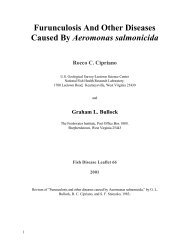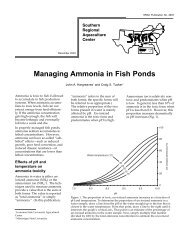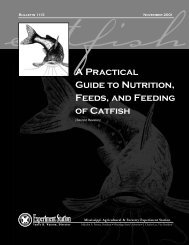Flavobacterium psychrophilum, cause of ... - cop.eXtension.org
Flavobacterium psychrophilum, cause of ... - cop.eXtension.org
Flavobacterium psychrophilum, cause of ... - cop.eXtension.org
Create successful ePaper yourself
Turn your PDF publications into a flip-book with our unique Google optimized e-Paper software.
more conventional toxic methods, but detection was on the order <strong>of</strong> 15 -150 cells for pure<br />
culture and 7,500 - 75,000 cells from seeded spleen tissue or ovarian fluids.<br />
Greater sensitivity was needed, however, to detect subclinical or covert infections.<br />
Consequently, a nested PCR assay was described by Wiklund et al. (2000) who utilized<br />
two universal primers (20F and 1500R) that were complimentary to conserved regions <strong>of</strong><br />
most eubacterial 16S rRNA in the first PCR step (PCR1) and the PSY1 and PSY2<br />
primers in the second stage <strong>of</strong> PCR analysis (PCR2). Such assay detected as few as 17-<br />
colony forming units (cfu) mg -1 in brain tissue and 110-cfu mL -1 in water. Nested PCR<br />
proved to be more sensitive than either culture or the indirect immun<strong>of</strong>luorescent assay<br />
for the detection <strong>of</strong> F. <strong>psychrophilum</strong> from water samples (Madetoja and Wiklund 2002).<br />
Using nested PCR assays, in which universal primers fD2 and rP2 were used in PCR1<br />
followed by PSY1 and PSY2 primers in PCR2, Taylor and Winton (2002) similarly<br />
detected as little as 14 cfu per sample. Baliarda et al. (2002) used the 20F universal<br />
primer and a new primer (Fpsy-interR) during PCR1 in conjunction with the FP1 and FP2<br />
primers described by Urdaci et al (1998) in PCR2. The resultant assay detected as few as<br />
10 bacteria mg -1 <strong>of</strong> spleen and 5 bacteria mg -1 <strong>of</strong> ovarian fluid. Terminal restriction<br />
fragment length polymorphism (T-RFLP) analysis also enabled detection <strong>of</strong> as little as<br />
30-cfu mg -1 <strong>of</strong> F. <strong>psychrophilum</strong> in kidney tissue (Nilsson and Strom 2002). Both a<br />
fluorogenic 5’-nuclease assay (TaqMan-based PCR) that detects as few as 4.7 cfu <strong>of</strong> F.<br />
<strong>psychrophilum</strong> per reaction (delCerro et al. 2002a) and a multiplex PCR that enables the<br />
simultaneous identification <strong>of</strong> Aeromonas salmonicida, Yersinia ruckeri, and F.






